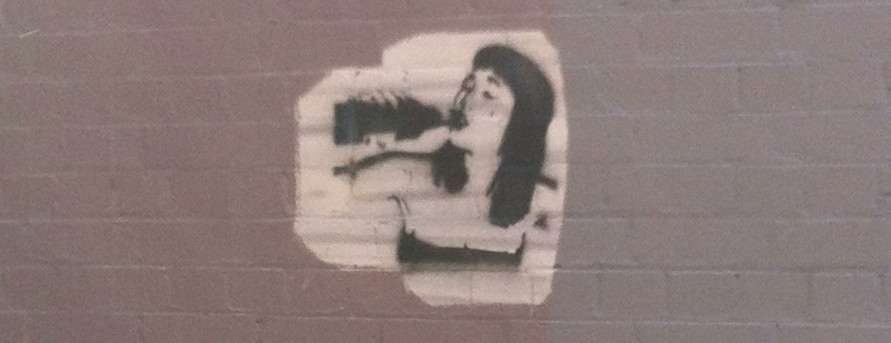A snippet from a recent conversation, not quite verbatim, but as much as I can recall:
person: everyone thinks (artists and writers) just go around drinking heaps doing drugs, having wild sex and parties all night long…
me: …
person: they don’t know that there’s actually quite a lot of work involved…
me: (thinks about rage associated with Paul Muldoon Oxford lecture collection) uh, yeah, it really isn’t, but I like the research except when my brain won’t switch off and read for fun.
In no way am I:
- suggesting I’m a writer
- admitting to believing or dismissing the particular stereotypes described above
- (unprofessionally) mad at Paul Muldoon, the famous Irish poet
- going to wax lyrical about whatever the hell it is that writers do
- going to avoid the blissful topic of alcohol consumption. Best for last, chums!
It’s actually really hard to read and drink because the ‘aspiring writerly’ brain is always looking to pinch, pilfer and transform better people’s words into their own (not referring to outright plagiarism and/or not citing sources – that shit is clearly not on. Some decent wordsmiths actually put effort into their craft, yo!).
A somewhat awkward slide to introduce Paul Muldoon’s The End of the Poem – a collection of lectures about individual poems for Oxford lectures. Muldoon is supposed to close read each poem, that is, analyse and beat it within an inch of its life for intent and meaning and whatever the hell it is litwank nerds do (disclosure: I do it but badly – they’re mainly just boring rants focussed on the possible reasons for the placement of a comma in one spot, etc.).
With close reading, you look for ways in which the poet has jampacked as much potential meanings and readings into as short a space as possible. So when Muldoon’s lecture about ‘poem X’ turned out to be ‘everything possibly related to the genesis of poem X and not really a reading of said poem, it got me into passionate Collingwood supporter mode (note: I do not follow AFL. Never been to a game but kind knowledgeable folks have offered to take me to my first game ever…next year.
It’ll be a good space to get my argh-Muldoon-why-so-info-overload-cant-drink-beer-while-reading rage. Basically, reading one of these lecture transcripts means (if you haven’t already) you’ll need to read five other poets, maybe a biography or two, and a bajillion other poems by the author of the poem allegedly being close read.
Stubbornly, I refused to let my Muldoon rage transfer to impressions of the beer. Reading non-fun stuff and drinking even funner stuff didn’t work – but just in this instance. Above, the beer is one of last month’s TruBru #bearclub selections – Sixpoint’s Spice of Life Citra IPA. Bring on the hop times. Hop times = fun flavour times. Screw autodidacticism. Link is back to full health – for now.
Michael Pollan’s The Omnivore’s Dilemma is, reading-wise, easier to devour though its information…not so much. Throughout the first part, I began to understand why Children of the Corn is a horror flick. It didn’t stop me from testing this new fear by buying a quesadilla a few days later. It also helps to know I’m not reading it blindly. Corn and its (natural) growth process still sounds like science-fiction. If we eat enough of it, will it conquer us the way the Adipose did in that episode of Doctor Who? Shudder.
It seemed like a good time to try out Mikkeller’s ‘Show Me’ Cuvee – a wild/sour beer (another TruBru #bearclub selection). My palate generally is doing funky things and has decided that things I previously thought were nice or okay, are ‘ooh-er, this is really good’ – enjoyed it more than expected.
Finally! I did get fun drinking and reading in! Woo hoo!
Snatching up some sun, my official mascot/overlord (cat) is resting against my back as I take a photo of The Paris Review summer 2014 issue (Northern Hemisphere summer – just imagine my lit journal reading backlog is the size of a slab) and 2 Brothers ‘Kung Foo’ rice lager. Both were very, very moreish. Ideally, enjoy both in a beautiful patch of public park not crawling with people who may follow you home singing Katy Perry or Britney Spears at the top of their lungs, or the equally intimidating crew who illegally light fireworks near a place I fondly call ‘Mill Park-South Morang Carcossa’. It makes trips to the postbox more…interesting than usual.
PS. The Muldoon lectures are amazing, just hard-going as it’s not the type of thing one can skim-read; I’m merely related to a Collingwood AFL supporter so their zeal is, to my mind, the stuff of mere legend; and lastly, po-mo dictates that you can appropriate others’ work but you better cite and acknowledge the shit out of your sources, k?
PPS. The other book supporting Muldoon-rage-o-rama is Mark Strand & Eavan Boland’s (eds.) The Making Of A Poem – highly recommended if you want to impress someone by memorising or learning to write poems in established forms (it has examples!)

